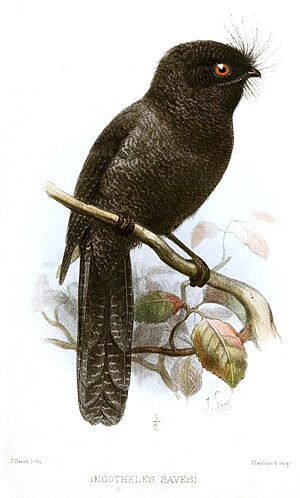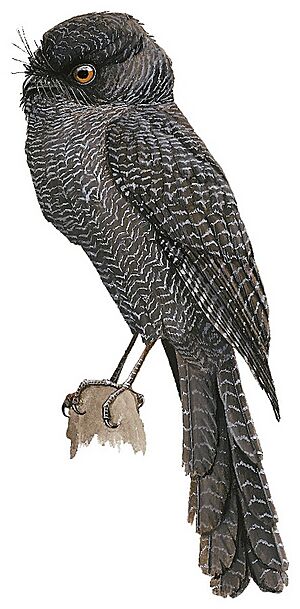New Caledonian owlet-nightjar facts for kids
Quick facts for kids New Caledonian owlet-nightjar |
|
|---|---|
 |
|
| Illustration by Joseph Smit, 1881 | |
| Conservation status | |
| Scientific classification | |
| Genus: |
Aegotheles
|
| Species: |
savesi
|
The New Caledonian owlet-nightjar (Aegotheles savesi) is a very rare and mysterious bird. It is also known as the enigmatic owlet-nightjar. This bird is quite large for an owlet-nightjar. It has grey-brown and black feathers with wavy patterns.
This bird has a long, slightly rounded tail and short, rounded wings. Its legs are long and strong. We don't know what its voice sounds like. Other owlet-nightjar species make sounds like churring or whistling. The New Caledonian owlet-nightjar is the second-largest known owlet-nightjar. Only the New Zealand owlet-nightjar, which is now extinct, was bigger.
Contents
Where It Lives and What It Does
The New Caledonian owlet-nightjar lives only on the island of New Caledonia. It can be found in Melaleuca savannas and wet forests. Most owlet-nightjars live alone. They build their nests in holes in trees. They usually hunt for insects from a perch. They fly out to catch insects in the air, or they swoop down to catch prey on the ground or on tree trunks.
We are not sure if the New Caledonian owlet-nightjar hunts in the same way. This species is larger and has longer legs than other owlet-nightjars. This might mean it spends more time on the ground. However, one sighting described the bird catching insects while flying in the trees. This suggests it might do both.
Why This Bird Is So Rare
This large owlet-nightjar is known from only a few records. The first bird was found in 1880. Another was found in 1915. There have been a few other confirmed or possible sightings since then. The most recent report was from 1998. During this sighting, a large nightjar was seen hunting insects at dusk.
This report makes scientists hope that the bird might still be alive. However, if it is, there are likely fewer than 50 of these birds left. Their numbers are probably still going down. The New Caledonian owlet-nightjar has sometimes been confused with another bird, the Australian owlet-nightjar. But they are different species with different features.
History of Discoveries and Sightings
First Discoveries
The very first New Caledonian owlet-nightjar was found on April 11, 1880. It flew into a bedroom in the village of Tonghoué. A person named M. Saves received the bird. He then gave it to Edgar Leopold Layard, a scientist. Later, in 1896, the Liverpool Museum bought this bird specimen.
Another specimen of the bird was found much later. In the early 2000s, a specimen from 1915 was rediscovered in a museum in Italy.
Later Sightings and Hopes
In 1939, a confirmed sighting was reported on the island of Maré. A bird was shot, but this specimen has not been found since. There were also possible sightings in the 1950s and 1960s. However, these sightings could not be fully confirmed.
Scientists have also found many fossils of this bird. These fossils suggest that the New Caledonian owlet-nightjar used to live all over the islands. This includes Grand Terre and Maré.
Conservation Efforts
In 1993, logging stopped in a large area of land. In 1995, about 7,500 hectares of this land became a special reserve. It is called the 'Reserve Speciale de Faune et de Flore de la Ni-Kouakoue'. This area does not get much conservation work. But it is very remote, which helps protect the birds there. We don't know yet how much this has helped the owlet-nightjar.
In 1996, a person named Daniel Letocart heard unusual bird calls. They sounded like an Australian owlet-nightjar. These calls were heard in the forests near the Tchamba river. Other local people also reported similar calls in 1996 and 1998. Since the New Caledonian owlet-nightjar is similar to the Australian one, these calls might have been from the rare New Caledonian bird.
The 1998 Sighting
In 1998, a group called Project Diadema saw the bird in the River Ni Valley. On November 5, 1998, at 6:40 PM, two people named Jonathan Ekstrom and Joe Tobias saw a bird fly across a dirt road. The bird started to hunt for insects in the air for about ten seconds. Then it disappeared. It came back to hunt again before vanishing completely. This sighting gave scientists hope that the bird might still be out there.
After this, many searches were done between 2002 and 2007. More than 500 days were spent looking for the bird. Over 120 people living in the area were interviewed. But no new confirmed sightings have been reported since then. This shows how incredibly rare and hard to find the New Caledonian owlet-nightjar is.



